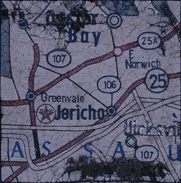
Buildings, like people, pass through time. That passage, regardless of its duration, describes the lives of buildings. This exhibit celebrates the relatively short life of an extraordinary building that played host to over six million visitors, the New York State Pavilion. Conceived, built and in use as designed for only two years, the Pavilion was witness to one of the most popular events of the 1960s, the New York World’s Fair. However unlike the Fair, the Pavilion and its exhibits reflected the contradictions, doubt, and cultural revolution that would come to characterize post-industrial America.
As a continuation of the 1939 World’s Fair theme of “The World of Tomorrow,” the organizers dedicated their new enterprise to “Man’s achievements on a shrinking globe in an expanding universe.” The New York State Pavilion embodied this theme in its massive volume and height, and for its floor incorporated the largest two-dimensional map then in existence, complementing the largest globe (the Unisphere) and the largest scale model of a city (the Panorama of the City of New York) also at the Fair.
The map pavement, a 22,000 square-foot replica of Texaco’s state road map was an immediate success and a monument for the times, combining innovative high technology and tradition with oversized pop culture imagery. The most extensive terrazzo project to be undertaken at the time, it was also one of the first large scale public Pop Art monuments. The map floor was irresistible to visitors who moved across its surface locating their lives in space. It also neatly captured the spatial theme of the Fair in a manner and with materials extending far back to Antiquity where mosaic map pavements substantiated geographic and cultural identities.
The New York World’s Fair was one of the last international expositions. No longer relevant as a way to bring the world to the public, the Fair as event and construction is obsolete. New appreciation of the architectural legacy of both the 1939 and 1964/65 World’s Fairs on this site has renewed New York City’s plans to transform Flushing Meadows Corona Park into a world-class cultural and recreational facility. This exhibition is part of that effort to bring public awareness to the pavilion and map as well as support for their rescue and conservation.